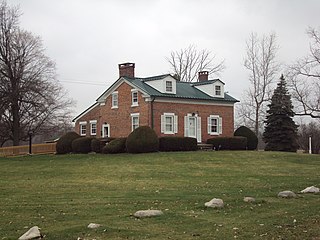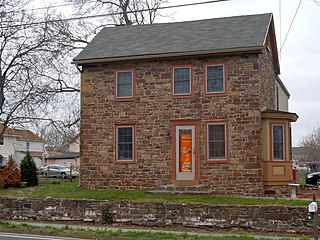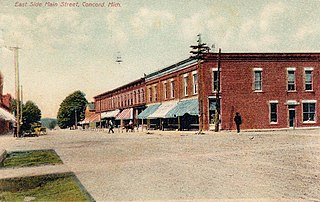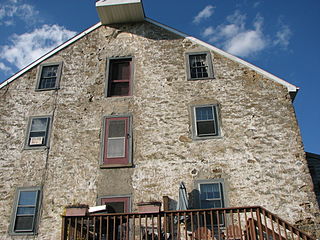Related Research Articles
Hunziker is a surname from Switzerland. The name most likely originates from the name of a small village in Canton Lucerne. Within Switzerland, the family expanded with a large presence in the Kulm, Zofingen, and Aarau districts of Canton Aargau and smaller concentrations in Cantons Berne, Lucerne, and Zürich. Significant emigration to the United States and Canada has occurred over several centuries. In the U.S., the name has commonly been anglicized to Hunsaker, Hunsicker, Hunsinger, Huntsinger, Hunsucker and many other variants.

The Masten-Quinn House is located on First Street in the village of Wurtsboro, New York, United States. It is a wooden Greek Revival house built in two phases in the 1820s, the center of a farm that remained working until the mid-20th century. Today it is one of the few remainders from the area's agricultural past as a canal town.

The Townsend House, also known as Lundale Farm, is an historic, American home that is located near Pughtown in South Coventry Township, Chester County, Pennsylvania.

Claremont City Hall, also known as the Claremont Opera House, is located at 58 Opera House Square in the heart of Claremont, New Hampshire, United States.

The Edward Loranger House is a private residence located at 7211 South Stoney Creek Road in Frenchtown Charter Township in Monroe County, Michigan. It was listed as a Michigan Historic Site on October 2, 1980 and added to the National Register of Historic Places on May 31, 1984. The house is significant as one of the oldest authentic structures in Michigan — having undergone very little modifications since it was first built.

The Evansburg Historic District in Evansburg, Pennsylvania, United States, is a National Historic District designated by Congress with over 50 National Register properties dating from the early 18th through 19th century. Almost all of these properties are privately owned and in active use at this time. The Evansburg Historic District was listed on the National Register of Historic Places in 1972.

The Concord Village Historic District in Concord, Michigan dates back to 1836, and consists of historic structures located along Hanover Street from Spring to Michigan Streets and North Main Street from Railroad to Monroe Streets. It was listed on the National Register of Historic Places in 1996.

Zion Lutheran Church, also known as The Lutheran Church of Middle Smithfield, is a historic Lutheran church located in Delaware Water Gap National Recreation Area at Middle Smithfield Township, Monroe County, Pennsylvania. It was built in 1851, and is a one-story, brick building in a modified Greek Revival style. It is built of brick made by members of the congregation and has a slate covered front gable roof.

The Delaware, Lackawanna and Western Railroad Water Gap Station is located in Delaware Water Gap, Monroe County, Pennsylvania. Service to Delaware Water Gap along what became known as the Delaware, Lackawanna and Western Railroad started on May 13, 1856. The station structure was designed by architect Frank J. Nies and built in 1903. It consists of two separate one-story brick buildings, a station house and freight house, joined by a common concrete platform and slate covered hipped roof. It is reflective of the Late Victorian style. The station closed to passenger service in March 1953, and was sold to the Borough in 1958. It is said to sit just outside Delaware Water Gap National Recreation Area, though it appears within the area's boundary on maps.

The Piety Hill Historic District is a historic district located in downtown Lapeer in Lapeer County, Michigan, USA. It was designated as a Michigan State Historic Site and also added to the National Register of Historic Places on July 26, 1985.

Adam Clarke Nutt Mansion is a historic mansion located at Uniontown, Fayette County, Pennsylvania. It was built in 1882, and is a large three-story, irregularly shaped brick dwelling in the Queen Anne style. A front porch and porte cochere were added sometime before 1912. It has a truncated hipped roof, four tall chimneys, and a centered tower section. The property includes a contributing fieldstone wall and a non-contributing two-story carriage house with a mansard roof in the Second Empire style.

McCoy–Shoemaker Farm is a historic home and farm complex located at Peters Township in Franklin County, Pennsylvania. The property includes a main house dated to the 1820s or 1830s, a 1+1⁄2-story stone spring house and dwelling built about 1800 with frame addition, large stone end bank barn, frame wash house, stone smokehouse, and brick privy. The main house is a two-story, five-bay, L-shaped brick building on a fieldstone foundation. The stone spring house may have also been used as a distillery.

The John Michael Farm is an historic American farm complex that is located in the Delaware Water Gap National Recreation Area in Middle Smithfield Township, Monroe County, Pennsylvania.

Capt. Jacob Shoemaker House is a historic home located in Delaware Water Gap National Recreation Area at Middle Smithfield Township, Monroe County, Pennsylvania. It was built about 1810, and is a 1+1⁄2-story, fieldstone dwelling over a banked stone basement. It has a gable roof with two dormers. The rear of the building has a two-story porch. It was the home of the locally prominent Shoemaker family.

The Warren Z. Cole House, now known as Indenhofen Farm and also known as the Kidder-De Haven House, is an historic, American home that is located in Evansburg State Park at Skippack, Montgomery County, Pennsylvania.

Phineas Pemberton House, also known as the Bolton Mansion, is a historic home located in Bristol Township, Levittown in Bucks County, Pennsylvania. It consists of four connected structures built between 1687 and 1790.

The John Burroughs Homestead, also known as Shady Hill and the Lieutenant Colonel James Hendricks Headquarters, is an historic American home that is located in Taylorsville, Upper Makefield Township, Bucks County, Pennsylvania.

There are two historic mills in the United States that have been named Warwick Mills. The older of the two is located in the Commonwealth of Pennsylvania and is no longer running. The other is located in New Hampshire and is still manufacturing today.

Clinger-Moses Mill Complex, also known as Clement's Mill, is a historic mill complex located in West Pikeland Township, Chester County, Pennsylvania. The property includes the site of two mills, a stone dam, a mill house, stone bank barn, and outbuildings. A former three-story grist mill built in 1860 has been converted to residential use. There is a four-story, three bay by three bay, fieldstone mill building. A five-bay, frame house has been built on the foundations of a former saw mill. The main house was built in 1801, and is a 2 1/2-story, fieldstone dwelling with a gable roof and two-story rear wing.

The Acworth Silsby Library is the public library of Acworth, New Hampshire, located in the town center at 5 Lynn Hill Road. Built in 1891 and funded by Acworth native Ithiel Homer Silsby, the building is a distinctive local example of Romanesque architecture. The building was listed on the National Register of Historic Places in 1983.
References
- ↑ Ticino Guide, Gerardo Brown-Manrique (Princeton Architectural Press: 1996) at 70: "On the road that leads north of Tesserete, just beyond the edge of town, Rudy Hunziker built his house and study. Dating from 1979–80, the structure marks the beginning of his professional career."
- ↑ "Habitation à Tesserette, Suisse; architect and owner: Rudy Hunziker", L'architecture d'aujourd'hui, 1979,206, pp 22–23
- ↑ "Casa Hunziker, Tesserete, Canton Ticino, Switzerland, 1980; architects: Rudy Hunziker", Toshi jutaku, 8/1982,178, pp 9–13
- ↑ "Archiplanet entry". Archived from the original on 2008-09-07. Retrieved 2008-05-22.
- ↑ National Register of Historic Places, Onondaga County, NY
- ↑ National Park Service Weekly List of Actions Taken on Properties: 2/10/97 through 2/14/97
- ↑ Historic Property Report, Hunsicker Farmhouse
- 1 2 Wetzel, Janet (1978–79). Monroe County Historic Resources Survey 089-H-161. Historic Resource Nomination. Stroundsburg, PA: Pennsylvania Historical and Museum Commission.
- ↑ Barber, Edwin Atlee (1903). Tulip Ware of the Pennsylvania-German Potters. Philadelphia: Pennsylvania Museum and School of Industrial Art. pp. 117–118. OCLC 142606.
- ↑ Ames, Kenneth L. (1977). Beyond necessity: art in the folk tradition. Winterthur, Delaware: Winterthur Museum. p. 117. ISBN 0-912724-05-6 . Retrieved 2009-09-15.
- ↑ Garvan, Beatrice B.; Hummel, Charles F. (1982). The Pennsylvania Germans: a celebration of their arts, 1683–1850. Philadelphia: Philadelphia Museum of Art. p. 175. ISBN 0-87633-048-0 . Retrieved 2009-09-15.
- ↑ Zacher, S.M., National Register Coordinator, Office of Historic Preservation. Letter to Mr. & Mrs. Edward Hunsicker. 25 November 1980. Monroe County Planning Commission, Stroudsburg, PA.
- ↑ Ramsey, G., Chief, Division of Preservation Services, Bureau for Historic Preservation. Letter to Janet Wetzel. 15 March 1983. Monroe County Planning Commission, Stroudsburg, PA.
- ↑ "Hikes-Hunsinger House". Archiplanet. ArchitectureWeek. 2006-12-05. Archived from the original on 2011-05-21. Retrieved 2008-09-29.
- ↑ "Claremont High School Historic District". Living Places. The Gombach Group. Retrieved 9 September 2016.
- ↑ Griffith, Clay (2009-07-31). "Claremont High School Historic District Boundary Increase and Additional Documentation" (PDF). National Register of Historic Places. Hickory, NC: City of Hickory, NC: 34–35. Retrieved 2010-10-08.
One-story with attic Minimal Traditional brick dwelling with an asphalt-shingle side-gable roof, interior brick slab chimney, dentil cornice, and eight-over-eight double-hung windows on the facade. The central entrance is recessed with a single-leaf six-panel door, fluted pilasters, and paneled reveals. The side elevations display six-over-six windows and louvered vents in the peaks of the gable ends. A single-leaf side entrance is located at the southeast corner of the house. A wood deck was added to the rear of the house around 1990. The house was built for Charles and Jane Hunsucker. A partner in the Callanan-Hunsucker Construction Company, Mr. Hunsucker was the son of Dr. Charles Hunsucker, who lived at 266 Fifth Avenue NE in the Claremont High School district.
{{cite journal}}: Cite journal requires|journal=(help) - ↑ Keiser, Albert Jr.; Angela May (2004). From Tavern to Town, Revisited: An Architectural History of Hickory, North Carolina. Hickory, NC: Hickory Landmarks Society, Inc.
- ↑ "Property Name: Unzicker-Cook House", National Register Searchable Database, Columbus, OH: Ohio Historical Society, archived from the original (PDF) on 15 April 2013, retrieved 24 February 2013,
National Register Reference Number: 74001404
- ↑ Owen, Lorrie K., ed. (1999). Ohio Historic Places Dictionary. Vol. 2. Somerset Publishers, Inc. p. 107. ISBN 978-1-878592-70-5. OCLC 40962724 . Retrieved 24 February 2013.
The Unzicker-Cook House is a trimmed fieldstone dwelling. The whole complex is the result of rational site planning. Although the buildings are simple in construction and plan, they provide necessary shelter and take advantage of local building materials and the sloping site. Daniel Unzicker (1798-1863) came from Bavaria, Germany, and emigrated to Milford Township where [he] purchased eighty acres of land. He farmed the land and increased his holdings to one hundred and sixty acres. The house, built around 1831, is built close to the hillside so it is protected from the harsh winter weather. The springhouse used the spring to keep its interior cool and moist. The smokehouse is largely exposed for good ventilation. It shows planning based on necessity and practicality.